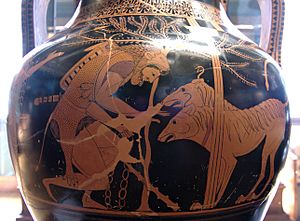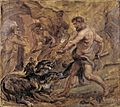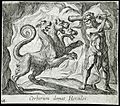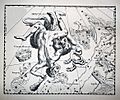Cerberus facts for kids
Cerberus (also known as Kerberos) is a famous creature from Greek mythology. Imagine a giant dog with three heads! This powerful hound belongs to Hades, who is the god of the Greek underworld. Cerberus's main job is to guard the gates of the underworld. He makes sure that no one who has died can leave, and no living person can sneak in.
Cerberus is a type of Hellhound, a mythical dog from the underworld. He is related to other amazing creatures like the Chimera, which was part lion, part goat, and part snake. Even though Cerberus was fierce, some myths say he liked sweet treats, especially honey cakes. He also seemed to enjoy music, as shown in the myth of Orpheus. Another way to get past him was to talk to his owner, Hades, as Heracles did. Cerberus is the son of two powerful monsters, Typhon and Echidna.
Contents
What Did Cerberus Look Like?
Descriptions of Cerberus have changed over time, especially how many heads he had. Most stories say he had three heads, but not always. Cerberus came from a family of multi-headed monsters. His father, Typhon, had many snake heads. His brothers and sisters were also multi-headed, like the Lernaean Hydra (many snake heads), Orthrus (a two-headed dog), and the Chimera (three heads: lion, goat, snake). Like his relatives, Cerberus was almost always shown with more than one head.
How Many Heads Did Cerberus Have?
The earliest description of Cerberus comes from Hesiod's Theogony (around 8th–7th century BC). In this ancient poem, Cerberus had fifty heads! Later, the poet Pindar (around 522–443 BC) said he had one hundred heads. However, most writers after that time usually described Cerberus with three heads.
One exception was the Roman poet Horace, who wrote about a Cerberus with one dog head and one hundred snake heads. To try and combine these different ideas, Apollodorus described Cerberus as having three dog heads, plus the heads of "all sorts of snakes" along his back. A later writer, John Tzetzes, said Cerberus had fifty heads, with three being dog heads and the rest being "heads of other beasts."
Cerberus in Ancient Art
In ancient art, Cerberus is most often shown with two dog heads. Sometimes he has three, but rarely just one. One of the very first pictures of Cerberus (around 590–580 BC) showed him as a normal single-headed dog. The first time a three-headed Cerberus appeared in art was on a cup from the mid-sixth century BC.
Was Cerberus Part Snake?
Many stories and artworks show Cerberus as part snake. This idea might come from his mother, Echidna, who was half-snake. His father, Typhon, also had snake heads. In art, snakes often stick out from Cerberus's body. Some pictures show him with a snake for a tail.
Writers also described Cerberus with snake-like features. Hecataeus of Miletus said he was a large poisonous snake. Plato mentioned his mixed nature. Virgil wrote about snakes coiling around Cerberus's neck. Ovid described his mouth as venomous and his hair as "inwoven with the threatening snake." Seneca said Cerberus had a mane made of snakes and a single snake tail.
Other traits given to Cerberus include having three bodies (according to Euripides) and multiple backs (according to Virgil). He was said to eat raw meat, have eyes that flashed fire, a three-tongued mouth, and amazing hearing.
The Capture of Cerberus
One of the most famous stories about Cerberus is his capture by Heracles. This was the last and most dangerous of Heracles's twelve difficult tasks. There are different versions of how Heracles managed to capture the fierce guardian.
According to one story by Apollodorus, Heracles asked Hades if he could take Cerberus. Hades agreed, but only if Heracles could control Cerberus without using any weapons. So, Heracles used his lion-skin as a shield and squeezed Cerberus around the head until the mighty dog gave up. Heracles then brought Cerberus to the surface world before returning him to the underworld.
Cerberus in the Stars
In 1687, an astronomer named Johannes Hevelius created a constellation (a group of stars) called Cerberus. In this constellation, Cerberus is shown as a three-headed snake held in Heracles's hand. Before this, these stars were part of the tree where the golden apples of the Hesperides grew.
Images for kids
-
Heracles, wearing his lion-skin, presents a three-headed Cerberus to a frightened Eurystheus hiding in a giant pot. An ancient vase (c. 530 BC).
-
Hercules and Cerberus. Oil painting by Peter Paul Rubens, 1636.
-
Cerberus and Hades/Serapis. From the Heraklion Archaeological Museum, Crete.
See also
 In Spanish: Cerbero para niños
In Spanish: Cerbero para niños













